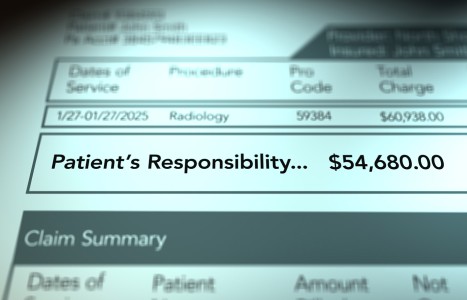On Oct. 21, 2025, a judge in Florida issued a groundbreaking decision in Complete Care v State Farm, 25-CA-1063. It concerns a fact pattern that many chiropractic doctors have faced wherein an insurer, such as State Farm or Allstate, decides to simply stop paying all claims submitted by a healthcare provider.
| Digital ExclusiveAdverse Reaction to Chiropractic Manipulation: Consider This Case
This article discusses an interesting putative case presenting to a chiropractic provider because of an adverse reaction experienced with a previous chiropractic provider. The patient reported to the examining chiropractor that she had previously experienced an adverse reaction to chiropractic spinal manipulation. The treating chiropractor at that time described her adverse reaction to be common.
In my 52 years as a chiropractor, I have never experienced a common adverse reaction to a spinal manipulation as described by the treating chiropractor. I do hope to stimulate some serious thought by the DC readers and hopefully a number of letters to the editor.
History of Present Illness
Subjective:
A 28 year-old female patient presents with a chief concern of, “I am having headaches, neck pain, and dizziness since getting a chiropractic treatment six months ago.” She went to the chiropractor because of a stiff neck.
When asked to point to the area of pain, she points to her neck (upper cervical spine) and the occipital/temporal areas bilaterally. Immediate palpation of the upper cervical spine does not reproduce the headache, but she mentions that turning her head to the right and looking up reproduces the headache and causes some dizziness. She has been experiencing difficulty completing her work as a consultant because of blurred vision, which interferes with reading.
Lying down and taking a hot shower reduces the pain in the neck and head. She does not relate any history of radiating pain into the arms or upper back. The severity of the headache is rated at 6/10 and interferes with her concentration and working at the computer. She takes Aleve for the headaches, but with little relief.
She says the previous chiropractor told her that her stiff neck was due to subluxation and that neck adjustments would relieve the problem. She says that she agreed to the treatment and that the chiropractor cracked her neck on both sides. Immediately following the treatment, she felt dizzy, sick to her stomach, confused, and tired. When getting off the treatment table, she had difficulty standing up and requested assistance to her car.
The doctor told her that she was having a reaction to the treatment with a release of toxins. He gave her a brochure that explained toxic release and then advised her to go home, drink a lot of water, and then go to bed. The chiropractor also advised her that she would be fine in the morning.
According to the patient, she threw up twice after she got home and experienced diarrhea. She claimed that it was difficult to drive home because of her blurred vision. It took 72 hours before she was able return to her normal activities of daily living. She did not return for second chiropractic treatment and denied seeking a second opinion about her condition.
Objective:
Vital signs: Height 67,” weight 125 lbs, BP 124/80, pulse 102, oral temperature 97.8 F.
Appearance: She is alert and cooperative, but demonstrates some confusion and anxiety.
Posture: She demonstrates pelvic obliquity with an inferior/posterior left ilium and a superior/anterior right ilium due to a functional short leg on the left. Her shoulders are rounded and she has a forward head carriage.
Gait: Unsteady with the tandem heel-to-toe gait testing.
Romberg test is positive with swaying and loss of balance with the eyes closed within 10 seconds.
Neurological testing: Sensory testing reveals hypesthesia in the upper and lower extremities bilaterally. Motor testing reveals 4/5 motor deficits in upper and lower extremities bilaterally. Deep tendon reflexes are 3+ in the upper and lower extremities bilaterally. Hoffman and Babinski signs are present.
Active maximum cervical rotary compression to the right is reduced, and produces both headache and dizziness with loss of balance.
Orthopedic provocative testing is not performed.
Assessment / Plan
I suspect the patient presented to the previous chiropractor with a cervical artery dissection and experienced a stroke post-cervical manipulation. I refer her to a neurologist for further evaluation and management. I call a colleague, one who specializes in stroke patients. The neurologist agrees to see the patient later today.
Discussion
In my many years of practice as a chiropractic specialist and 19 years of experience teaching at a chiropractic school, I have never read literature that describes a toxin release post-cervical spine manipulation. I hope to hear from readers of this article if there is any literature that supports this theory of toxin release post-manipulation.
The brochure given to the patient discussing toxin release did not provide any references. Hence, I doubt the veracity of the brochure and challenge the intentions of the author. Here’s what the brochure said:
If you’re new to chiropractic, you’ve probably spent some time preparing yourself for your first visit. If so, you may have heard of toxic release. After your first chiropractic adjustment, you may experience slight cold or flu-like symptoms. It’s not because the chiropractic practice did something wrong or the practice is unclean, but because of toxic release. Here’s what you need to know.
Toxic Release: What Is It?
Approximately 20% of patients experience toxic release after a chiropractic adjustment. It might sound intimidating, but it should be considered a positive reaction to treatment. The toxins in the body are being released by chiropractic manipulation, which is great news! With that great news comes a slight downside in that expelling the toxins in the body comes with some unpleasant, albeit temporary, symptoms. Fortunately, you can take comfort in the fact that your body is adjusting to the removal of toxins and the pesky side effects will soon fade.
Toxic Release Symptoms
If you do experience toxic release (and the vast majority of chiropractic patients do not), the symptoms include fatigue, headache, night [sweats], tight muscles, and diarrhea. Feeling fatigued after an adjustment is also common because the body is adjusting to the way the nervous system responds to treatment. Before an alignment, the nervous system is usually blocked by subluxations. With the use of chiropractic treatment, the subluxations are removed and nerves function optimally, which can be tiring at first as the body has been deprived for some time.
Toxic Release Truth
The body is reacting to chemical signals between the spinal cord and the brain all day long. When that flow of energy is disrupted because of subluxations (also known as dysfunctions of the spine), daily action is slowed down. Clearing the blockages and interruptions allows energy flow to return to its optimal speed, but means the body needs an adjustment period, leaving it feeling tired and even sick.
Imagine your nervous system is like a garden hose. When there’s a kink in the hose, water gets jammed up and cannot flow. This also applies to the nervous system. If there is a subluxation present in your spine, it causes pressure to build up by blocking the flow of energy. That pressure then causes many ailments including headaches and chronic issues. Once that pressure is released with chiropractic care, the renewed flow of energy can cause some cold-like symptoms. Keep in mind that toxic release symptoms don’t last long, and chiropractic will soon have you feeling great!
Quiz Time
- Signs of a cervical artery dissection include posterior neck pain and stiffness, blurred vision, weakness or numbness, loss of balance, and dizziness. True or False
- Spinal manipulation and provocative orthopedic testing of the cervical spine are contraindicated when a patient presents with the signs of cervical artery dissection. True or False
Answers: 1. True. 2. True.



